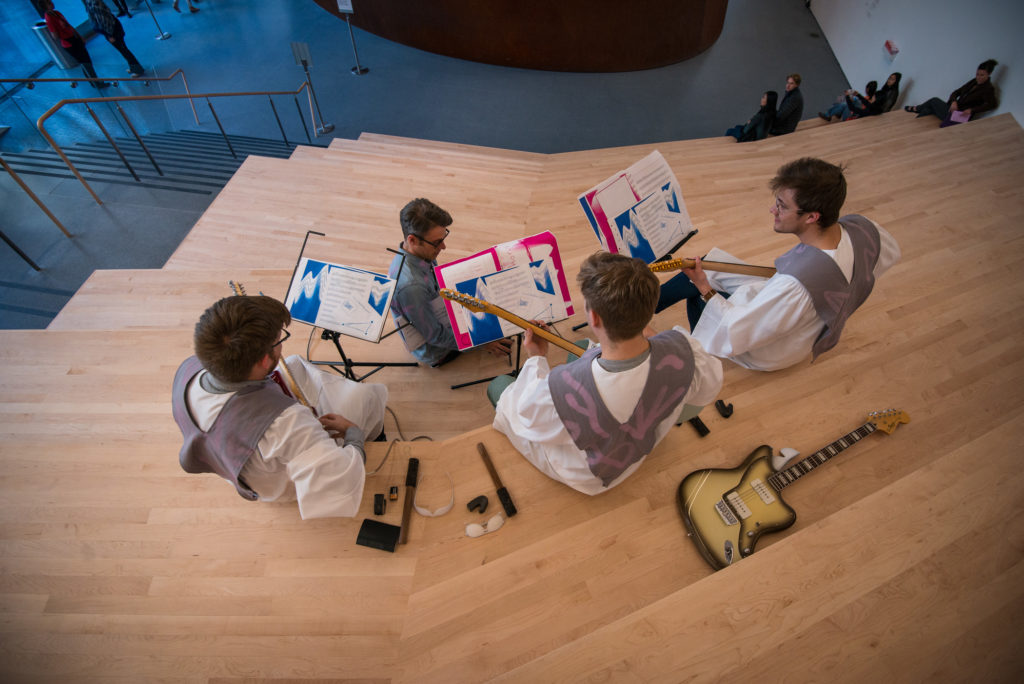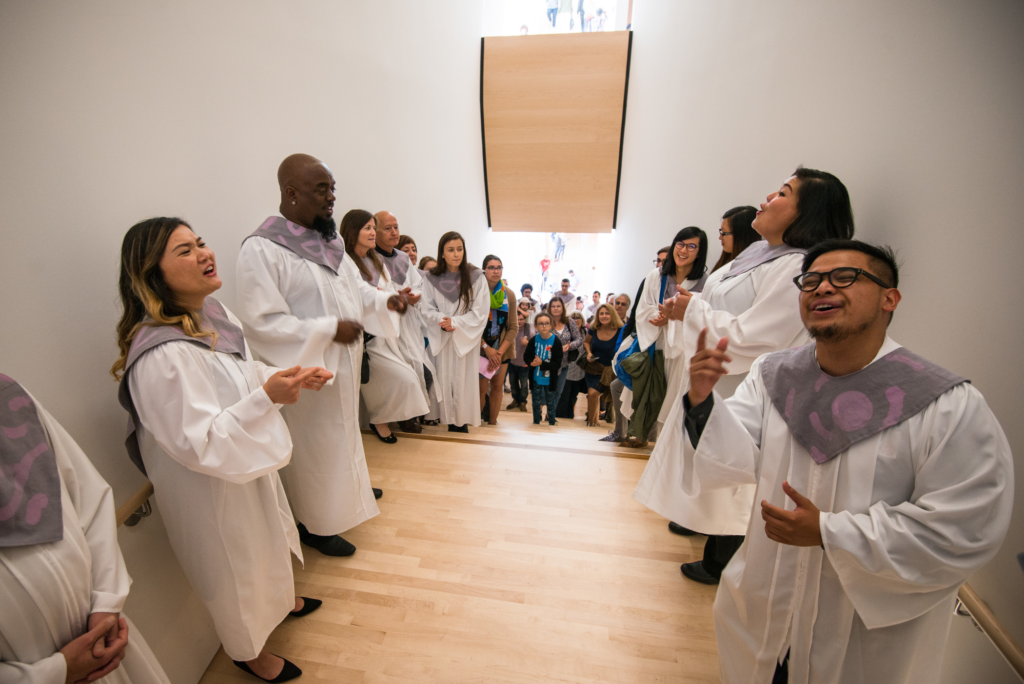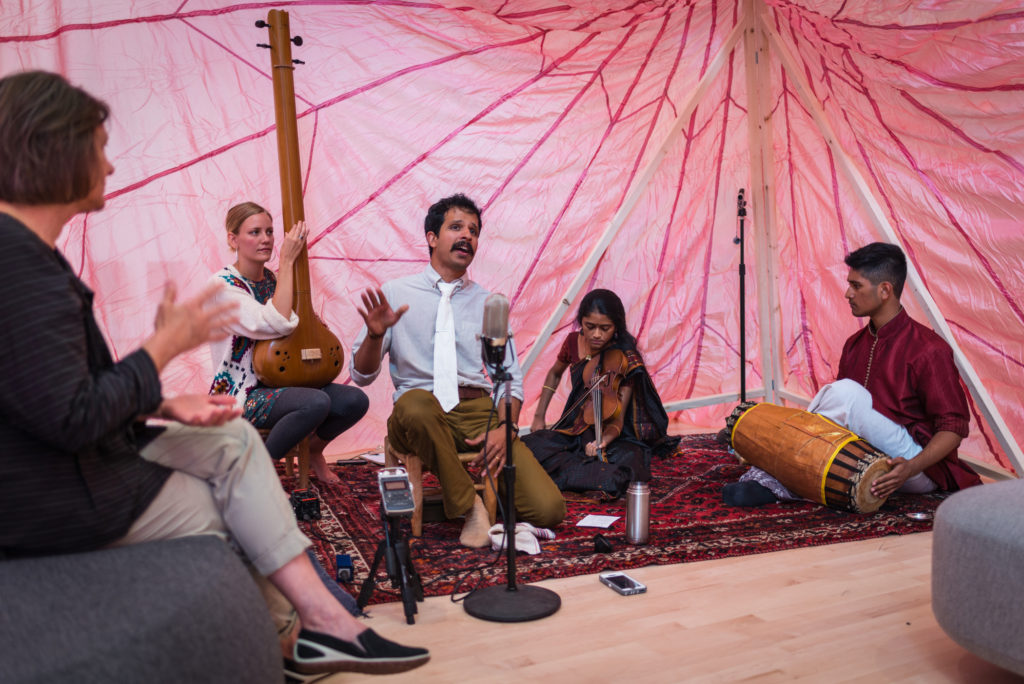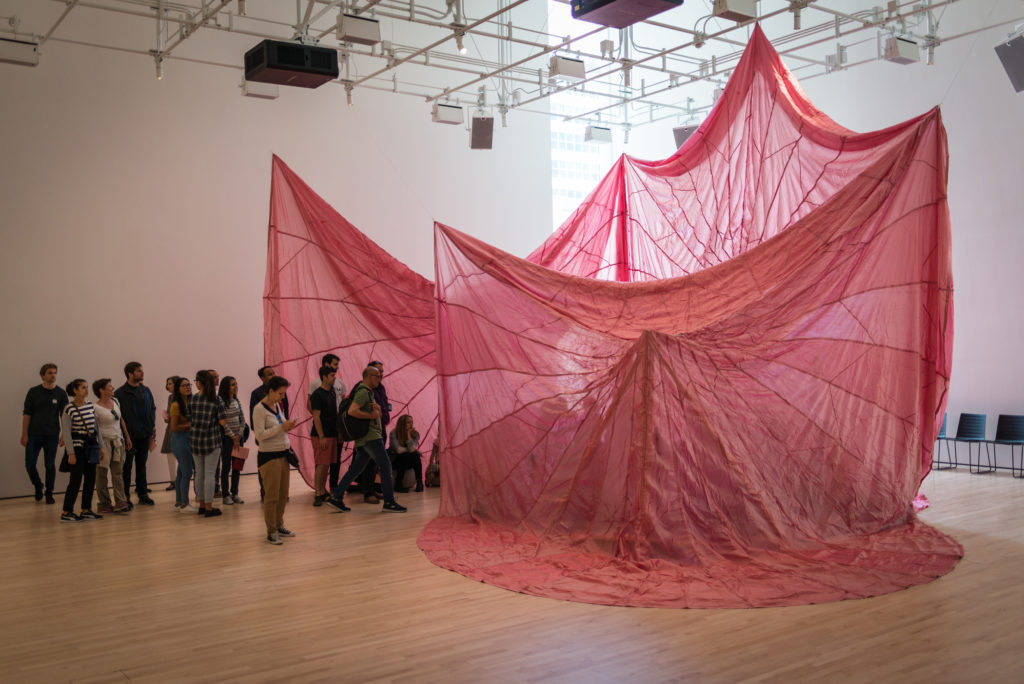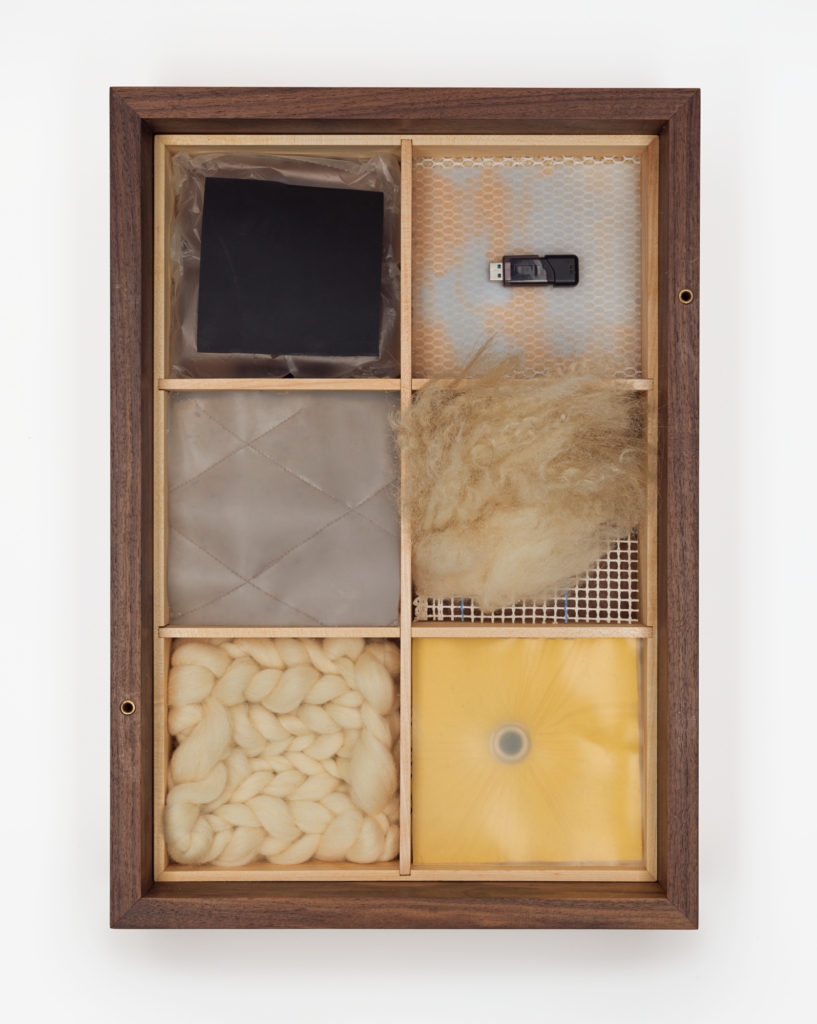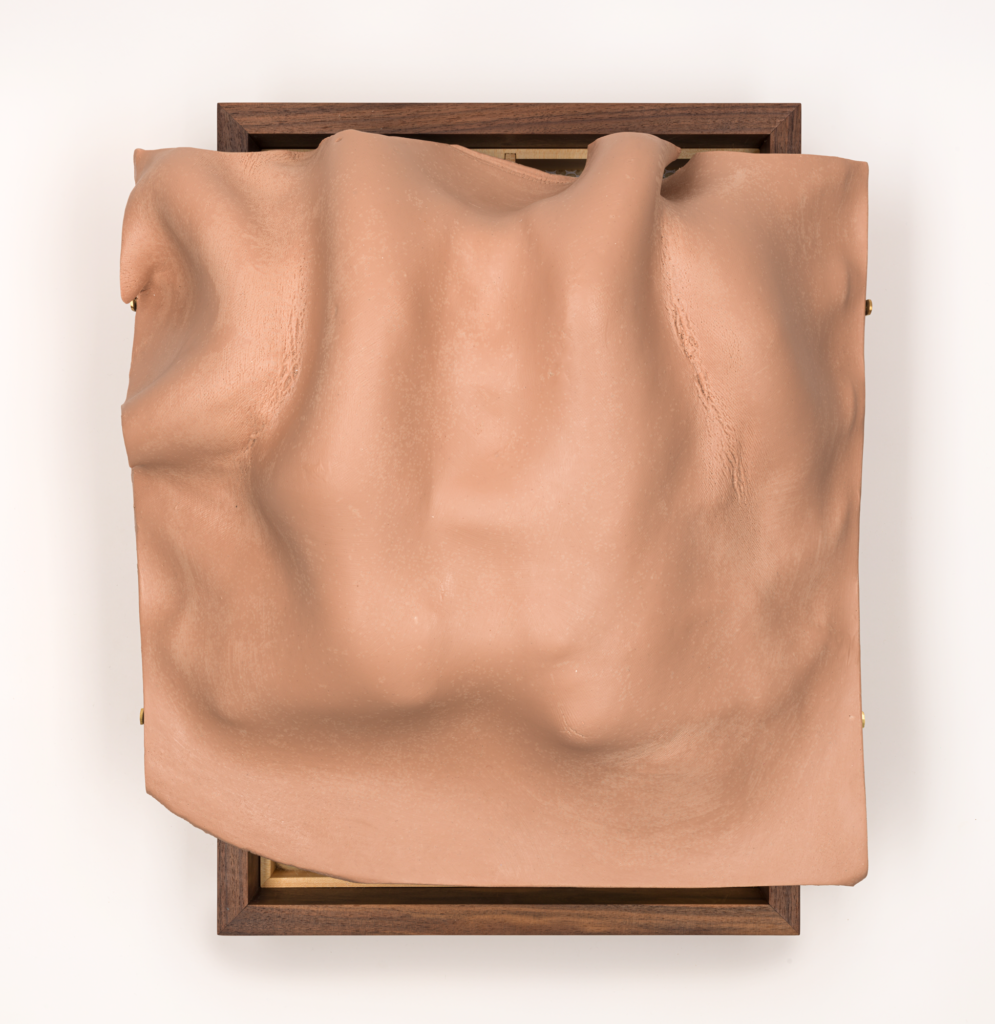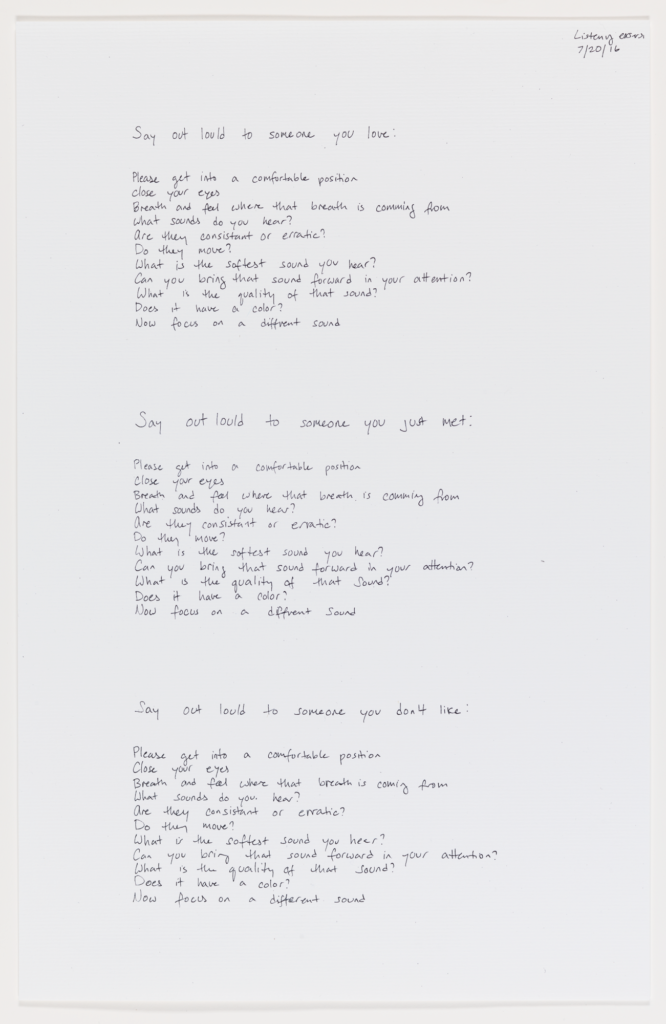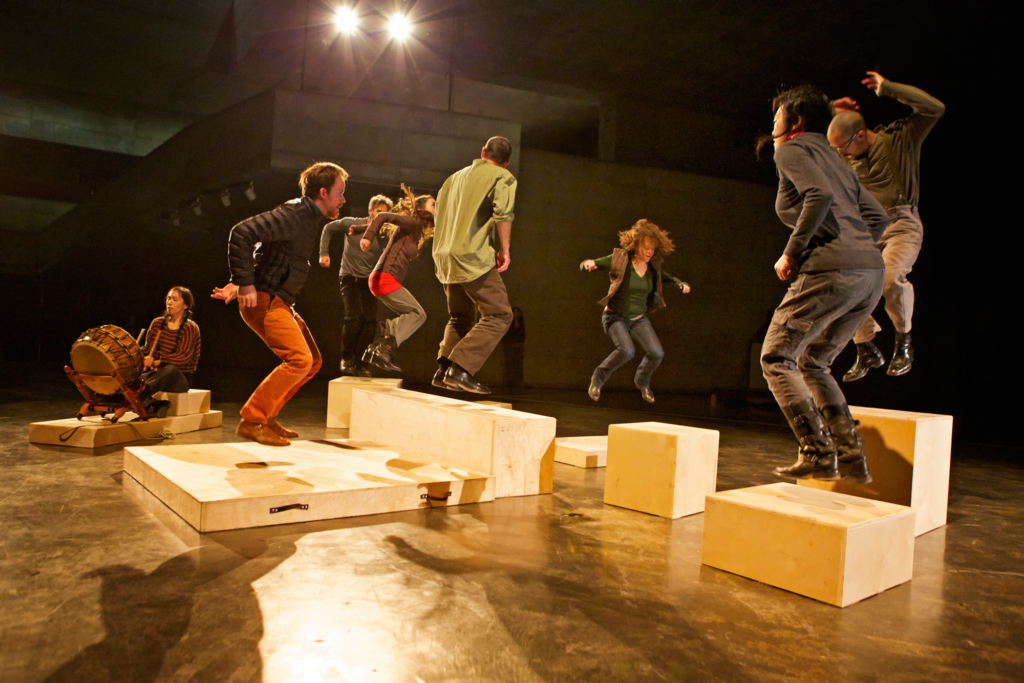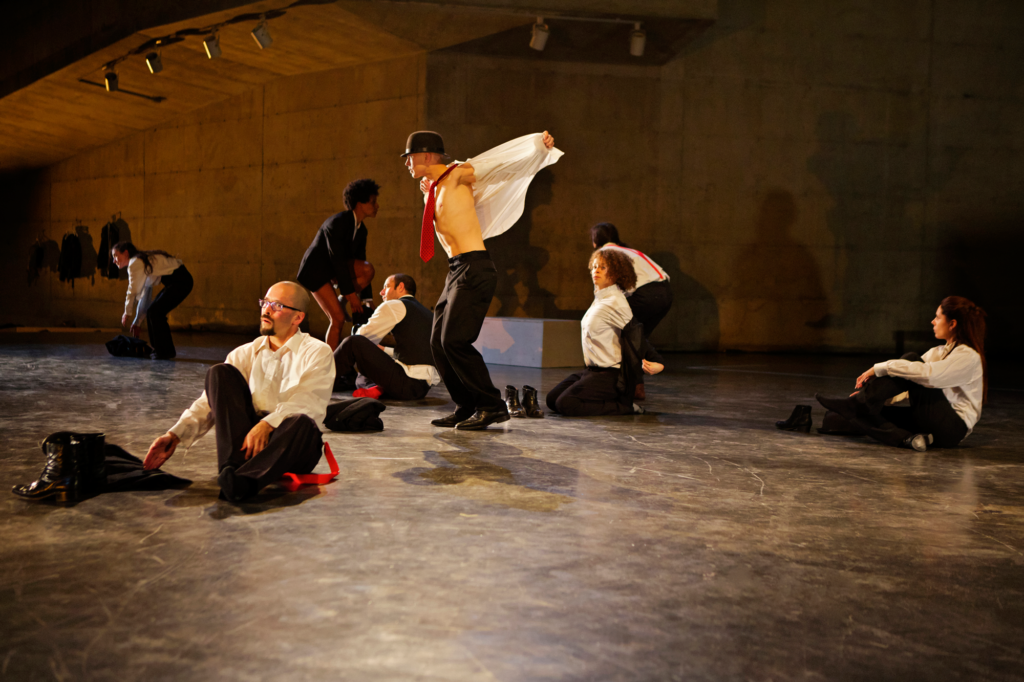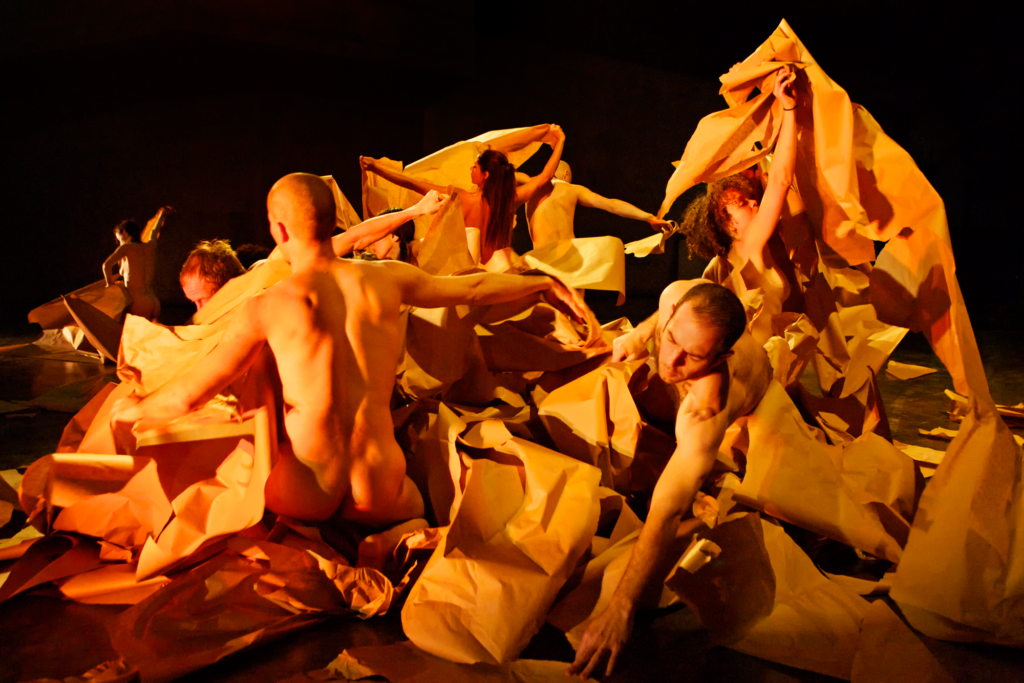Frank Smigiel, associate curator of performance and film at SFMOMA, and Dena Beard, executive director of The Lab in San Francisco, have supported live work and initiated performance residencies at their respective arts organizations. Here they speak about sound in relation to performance and institutional space.
Frank Smigiel: If we think about the early avant-garde and the shock of the new, we might think of it all as being Stravinsky-like: the thing that shocks you into modernity is the startling noise, not the startling painting. Sound occurs as the first disrupter. I know for many of us in this field, just like for any other kid in America, our first art form was music. If you’re a kid and you’re into something that’s going to be estranging or surprising or new, you’re going to be into punk rock or death metal or atonal music. I mean, if you want to annoy your parents, you turn it up—you don’t do a messy, splashy painting on the fridge.
So I wonder, is there something inherent in sound that is always about disruption?
Dena Beard: Absolutely. What brought me into The Lab as a viable space for that disruption was analyzing human behavior—how people respond to live art, and specifically how they respond to sound. There is a penetrative quality to sound. It moves into your body and compels you to react. If you’re at a punk show, you either move to the edges of the room because it’s quieter or you throw your body against the noise. There is a push and pull to how we behave in sound spaces, whereas in a museum we sense immediately that the institution has created a frame for objects and, by extension, also our behavior around those objects. As a result, we move through the museum almost unconsciously. I’m interested in the history of how art became regulated in this way, and in the moments when we begin to deregulate art and our habits and behavior in relationship to it.
There has been a much more dramatic resistance to the institutionalization of sound than to the institutionalization of the visual arts, which were always more closely aligned with the ruling class. I’m thinking of Pierre Boulez’s IRCAM (Institut de Recherche et Coordination Acoustique/Musique), as well as the friction in early Dadaists’ and Surrealists’ deployment of musique concrète and their questioning of how systematic those forms should ever become.
At what point are we still creating spaces for freedom?
FS: Right. Even as institutions try to create a boundary for sound, they’re not very good at it because of the nature of sound. Like you say, you can’t get away from it. It’s somehow unruly from the get-go, because of the way it spreads; you can’t contain it in the same way that you can frame an object that has borders.
DB: Exactly. There is an ongoing debate about using headphones as a way around that because sound is generally a shared experience. It’s something that we experience with other people.
FS: It makes me think, too, about the arc of avant-garde practice in the twentieth century. If you think about musique concrète not wanting to be institutionalized, and you think about Allan Kaprow writing that Jackson Pollock had ended painting, because the gesture had become more important than the mark on the canvas, suddenly you’re thinking about the environment, and sound returns us to the environment. In a way sound will always be the dominant note in any kind of intermedia space, because it’s sound. It doesn’t go away. And it sticks to those spaces.
DB: Yeah, it’s difficult to abstract music from memory. We have a sense memory of melodies, and a sense memory of tones. Hearing an electronic sound is different from hearing fingers strumming a guitar. The way we respond is very much dependent on how we’ve experienced those sounds throughout our lives. We’ve become more accustomed to electronic sounds recently, but they still tend to provoke this archaic idea that the work is synthesized by machine rather than by the artist’s hand. And so people might expect an abstract, mechanical performance when electronic sounds come into the fray, and you’re always trying to dismantle those expectations.
FS: One sonic dismantling we’re familiar with is the split between music and dance led by Merce Cunningham and John Cage. Since you’ve been at The Lab, how have you seen artists work out the legacy of how sound and movement relate to each other? And how they relate to the audience and to the space? Is the action keyed to the rhythm? Or is there a deliberate attempt to make them independent channels?
DB: It’s complicated, because you’re bridging many different languages, from the way people respond to the room to how they respond to what other people are doing. Asking artists to work together, to create spaces of freedom for each other is also a very loaded request. Jacqueline Gordon’s sound pieces for Inside You Is Me (2016) were synthesized right before each performance to respond dynamically to the visual and acoustic architecture that she arranged in the space. Then she brought in dancers, who were there to move alongside the sound, certainly, but also to enact their own understanding of how that space created or withheld agency. And sometimes the dancers’ movements ran counter to the sound in inspiring ways: they reacted against certain sounds, or refused to comply with the—
FS: With the order of the music, or the tempo.
DB: Exactly. Certain sounds definitely alluded to the nightclub—processed dance beats with heavy bass—while others were pared-down motifs, effecting a knee-jerk replication of the Judson Church school of movement.1 Dancers hold all of these movements in their bodies, but the artists would sometimes understand that they were being manipulated by these sense memories, these histories, and they would fight against that and would try to do a very minimal movement in the middle of a faster-tempo beat. I think of that push and pull in Anna Halprin’s Parades and Changes, which first inspired me to start working with performance.2
FS: Visual art is most often presented as finished, even if it’s the end of a process piece—the people are gone, the installers are gone. The difference with sound and with performance and movement is that the people are not gone. [Laughs] There’s still something incredibly disruptive about the presence of a live person in the art experience. As we become more of a photographic culture, we want to control our images, we want to control our experiences, we want to edit them later, craft them into narratives—and that gets messy when there are other people involved and if they’re performers. I’m increasingly struck by how many people have no experience of liveness.
DB: [Laughs] It’s true.
FS: When we had Chris Kallmyer doing A Paradise Choir at SFMOMA last year, there was one moment where he had roaming choirs throughout the museum, and I was struck by the younger kids in the audience who would try to get very close to them. I’m almost certain they had never seen someone singing in person rather than on TV.3
The question is always, How am I positioned against this person who is doing something? I don’t know that when you see a piece of visual art you think a lot about the scene of its production. Maybe that’s true for big gestural paintings from the 1950s—you want to imagine the heroic dance the artist was doing to make it. But with sound and music, I wonder if you’re still imagining the source of its production, or if it fades and becomes . . . I mean, the title of this show is Soundtracks, and the dilemma of the soundtrack is that it’s subsidiary to the main action. It’s the very opposite of what we’ve been talking about—the idea that somehow sound over-determines the environment. One of the works in the show is a Chris Kallmyer/Mark Allen piece, Live Personal Soundtrack (2010/2017), where you wear headphones and a guitarist follows you around the museum and plays for you. It’s like a personal journey soundscape, but live, not mediated through your phone.
I keep wondering if some of the desire to make sound a kind of avant-garde gesture in the institution is nostalgia for a time when that was possible, as now it’s become more of a lifestyle environment, an ambient backdrop to our lives.
DB: Absolutely. The way that we inhabit spaces with sound is different from how we inhabit them with no sound. If you go into a café and it’s completely silent, there’s something a little creepy about that.
FS: Completely.
DB: Jackie Gordon always talks about the tyranny of going to the gas station and having to listen to an Adele song while she’s pumping gas—you know, just that kind of control. Or if you think of Guantanamo, and the use of certain kinds of music as—
FS: As torture.
DB: Yes, rock music as torture. And so the idea of the soundtrack as not being one of the most powerful components of our work is curious to me. We can’t think of the sound as being below the surface of cognition in the space of art; it is an enormously powerful component of all work. Even if you’re showing a video piece in a gallery, the soundtrack or the dialogue will bleed over to other spaces. Someone will be looking at a painting while listening to the soundtrack from that video along with the clicks of heels on the floor, the sputtering of the museum guard’s walkie-talkie, the hum of voices from the floor below . . . The body’s experience of an artwork is never autonomous; it is always shared. Likewise, our experience of the commons, of collective space, is in large part an experience of sound.
To return to your earlier point about the painting on the wall and whether you’re acknowledging the installers who put it there and the artist creating the work—when you experience a sound piece, you are listening to it being made in a specific way. It’s durational, it’s about time, but it’s also about labor. We often have more opportunity to take notice of that labor through durational listening, whether it’s hearing seven artists recording together in a studio environment, one person behind her synthesizer, or watching three people improvising live in front of an audience. Or even a guitarist following people around. Having to interact with a human being in space—or human labor, in the sense that they’re tasked with doing that for a certain period of time—changes our commitment to the work and our feelings about whether or not it is of value.
FS: I wonder if we’re coming into a period where silence is increasingly important given the noise everywhere else—where the interval, the not-noise, is becoming more important because we desire so many inputs.
DB: The best artworks are those that listen while they perform. Even if the work is incredibly dissonant, or difficult to comprehend, there’s space for reflection, for the world to bleed back into it. I hold on to this idea when looking at all works of art: Is it a closed system, shut off to the world, or does it breathe the same air that I breathe?
FS: I recently saw Stephen Petronio’s company perform Yvonne Rainer’s Trio A with Flags. Trio A is a classic Judson dance—throw the ball, go down, stand up—but Trio A with Flags was a later iteration, a Vietnam protest. The performers are naked, and they’re wearing American flags like bibs. Rainer often performed both pieces to rock music, so this Trio A with Flags was performed to “River Deep, Mountain High” by Tina Turner—apparently the first song she did without Ike, though it’s credited to him too. So the whole narrative of Tina Turner and the Phil Spector Wall of Sound are brought into it as well.
What was amazing was seeing the audience refusing to react to it. Everyone was sitting there, trying not to be like, “Yeah, yeah” [sings], because they were at a dance performance. It was remarkable, too, to see the tug of war between the movement and the music. Where does a song like that, a figure like Tina Turner, fit into this pared-down Judson dance piece that had itself been repurposed as a political protest with flags? Everything going in the wrong way of your desire was so great. And for me, too, I love this piece by Rainer [Trio A], but I’ve never seen it done by three people at the same time, with all of this color on all of the flags—
DB: The anti-minimalist version.
FS: Completely. It was the baroque version of Trio A. [laughter] All the preparedness was disabled for me in that moment, because I thought I knew the piece I was going to see, and then three things happened that I didn’t know.
DB: Yeah, and that’s the point of the piece. It’s so beautiful; it is the conflation of the political and the personal in a very specific way. In Parades and Changes, too, there is a passage where a Beach Boys song comes on and the dancers undress very slowly, out of rhythm with the music—the instructions in the score are to not sync with the beat, to refuse to acknowledge the song. And so as a viewer you’re trying to watch the dancers while also acknowledging the song, and acknowledging the dancers not acknowledging the song. You feel the rhythm of it, but you also feel this sinister control that the song has over you; it wants you to sync up with it, and the way that confusion becomes this ambivalent experience of the dance is critical.
FS: There’s something about the comfort level with confusion or not knowing. One of the reasons I tend to have a bias against the use of pop music is that it’s easy. In a lot of artists’ work that deploys pop music, the song wins and the work just goes away, or the work rides it in some way. But so much of what you do, and some of what I do, is not about legible music structures. So I think a lot about how to create that entry point where people feel safe to walk into the room, to get into the pool and learn how to swim.
DB: Seduction plays a big role. At The Lab, we typically offer very little interpretation. We sometimes offer tracks or videos on our website, and maybe a bio of the artist or a short description of the piece. The seduction of getting people into the room to have an experience with the work regardless, to be open to the unknown, is seventy-five percent of the job.
FS: The value of a space like The Lab is that it can function as a kind of production studio. It’s not possible in the same way in a large institution, where there are constraints like who has to turn on the lights, what security has to be in place, and so on. The independent artistic space, which is in itself potentially threatened, is still the place where these residencies and productions can happen.
DB: And it’s up to all of us to figure out how we can continue to create that space.
FS: There’s also an expectation that institutions have clear borders, and an expectation that you’re allowed not to have those.
DB: Yeah. There should be an ecosystem of those types of experiences, and maybe SFMOMA is a gateway drug for people to come to The Lab and experience something akin to an Oakland warehouse show or performance art in a loft in New York.
FS: And we think of The Lab as the theater drug for SFMOMA. [laughter] We all have audience envy is maybe what we’re thinking about.
Notes
- The Judson Dance Theatre was a collective of choreographers and performance artists—Trisha Brown, Lucinda Childs, Philip Corner, David Gordon, Deborah Hay, Meredith Monk, Steve Paxton, Yvonne Rainer, Carolee Schneemann, and James Waring—who championed movements based on ordinary gestures and rejected the narrative ostentation of traditional dance. They performed at Judson Memorial Church in New York starting in 1962.
- First performed in 1965, Parades and Changes allowed for a radical renegotiation of the roles of the dancers, choreographers, and sound and lighting designers, and is considered one of the origin points of postmodern choreography. Each performance depended on rehearsed movements combined with improvisation and a shuffled set of rules, and the results differed every time it was performed. [Editors’ note: Dena Beard curated Anna Halprin/MATRIX 246 at the UC Berkeley Art Museum and Pacific Film Archive in 2013. In celebration of the architecture and history of the museum’s Mario Ciampi–designed building, and in preparation for the museum’s move to a new location in 2015, the exhibition featured Halprin’s final staging of Parades and Changes (1965), which had been presented there in 1970. See Anna Halprin/MATRIX 246 at the UC Berkeley Art Museum and Pacific Film Archive website, accessed June 13, 2017, https://archive.bampfa.berkeley.edu/exhibition/246.]
- For more on A Paradise Choir, see Chris Kallmyer and Frank Smigiel, “Paradise is Exactly Like Where You Are Right Now,” Open Space, July 22, 2016, https://openspace.sfmoma.org/2016/07/paradise-is-exactly-like-where-you-are-right-now/.
